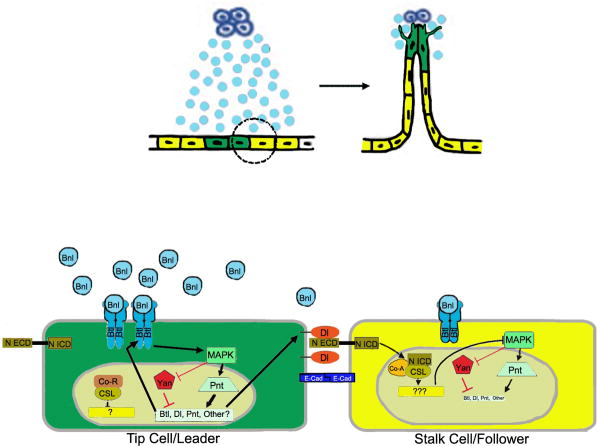Figure 2. Model for tip cell selection.
In the top panel, dorsal branch cells in the tracheal epithelium are schematized receiving a signal (light blue) from FGF-secreting cells (dark blue). Two cells are selected as tip cells (green) while the other cells will become followers (yellow). Interactions between a leader and follower cell (circled) are shown in the enlarged bottom panel. The two tracheal epithelial cells are held together by adherens junctions, featuring homophilic interactions between Drosophila E-cadherin (E-Cad) on the surface of the two cells. Initial slight differences in FGF signaling are amplified by positive and negative feedback loops. Breathless FGFR signaling (FGF: Branchless/Bnl, FGFR: Breathless/Btl) through the canonical mitogen associated protein kinase (MAPK) pathway–here represented only the terminal kinase in the pathway, MAPK–results in phosphorylation of the ETS box transcription factors Pointed (Pnt) and Yan (encoded by anterior open). Phosphorylation of Pointed activates transcription of breathless, Delta (Dl), and pointed itself. Transcription of breathless and pointed is expected to increase FGFR pathway activity, while Delta (Dl) activates Notch (extracellular (N ECD) and intracellular (N ICD) domains indicated). Proteolytic processing of the ligated Notch receptor releases the N ICD, which associates with the transcription factor CSL (CBF1/suppressor of hairless/Lag1, light gold oval), and co-activator (Co-A, in Drosophila, mastermind). Activation of Notch antagonizes MAPK, downregulating the FGFR pathway and Delta expression in the follower cell.

